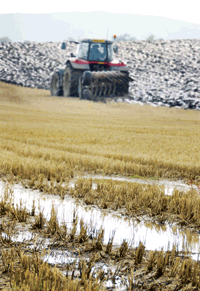Soil Protection Review takes a more practical approach

The purpose of the SPR is to maintain soil structure and organic matter, preventing erosion, compaction and damage to landscape features. Everything you need to do to complete the SPR is good practice and will help to get the best from your soils and improve profit, so there’s no reason not to start now, says Mr Draper.
“The new SPR takes a more practical and useful approach, aiming to improve soils and to identify how best to do this.”
The review sees some changes that growers need to be aware of. First, access to waterlogged land no longer needs an exemption, but where access is necessary, growers must identify, record and make good any damage, except in certain limited circumstances. The SPR provides a table on which to record access and show plans for repair.
This year’s form offers the option to classify soils either on a map or in a table. Mr Draper suggests that the table is easier to work with in the first instance.
There is also an optional questionnaire on the use of grass buffer strips on arable land next to watercourses this year. Many growers will have these under existing stewardship or other agreements. They can contribute towards targets under the Campaign for the Farmed Environment and the EU Water Framework Directive, says Mr Draper.
A change brought in last year follows an EU auditors’ finding that the RPA had been too lenient in issuing warning letters rather than financial penalties. Most negligent cross compliance breaches will now attract a 3% SPS deduction. However, the most common breach in the past has been a failure to complete the SPR at all, says Mr Draper, and this is likely to incur a 5% reduction if the farmer has been negligent.
Growers must choose at least one of five post harvest management options following combinable crops to reduce the risk of erosion. “If you are going to choose the cultivation option, for example, you need to have an idea of how you are going to carry that out, so it’s best to start on the SPR sooner rather than later so you can plan your operations.”
SPRs must be updated during the year if it becomes clear that the soil management measures chosen are not working, if additional land is added to the holding, or if management systems or cropping practices change. During 2010, inspectors will also check that any measures in pre-2010 SPRs have been implemented. Inspectors will also request to see the information in the blue continuation sheet for 2009.
After two wet winters, few holdings won’t have experienced soil management challenges, says Mr Draper. “You need to recognise the issues and take or plan reasonable steps to address them and record what you have done or what you plan.”
When identifying risks to soil for the SPR, it’s important to be truthful, says Mr Draper. Otherwise when it comes to choosing the land use measures to address the risks later in the process, the correct ones will not be open to you, he warns.
“Cereals don’t present a particular problem as far as the options go, you usually have to choose two, but for maize and potatoes on high risk land you need to choose three options and that is going to be difficult in many cases.”
He also urges growers to spend time getting the correct soil classification for the SPR. “About 80% of soils will fall into the medium classification, carrying a moderate risk, unless the grower chooses to upgrade them to high risk.”
Where a medium soil is given high-risk status in the SPR, the reason for this must be explained in the soil risk table. Not everyone has caught up with this, says Mr Draper. “Any farm will obviously have a range of soils. You need to do the SPR classification field by field and get it right. If you think all your soils fall into one classification, you can check this by having just your lightest field and heaviest field sampled and if both are medium, then so is everything else in between.
“The implications of getting it wrong go wider than the SPR and an SPS payment deduction. These documents could be used as evidence in flooding or pollution cases and you need to make sure that you have acted with due diligence in classifying soils.”
Taking more time to assess soil structure as part of the SPR can cut cultivation costs, reduce compaction and increase yields. “It’s always worthwhile to look at soil structure on a field-by-field basis annually to determine the best cultivation techniques for next summer, you’re only doing what is best for the land,” says Mr Draper.
While this is not an absolute requirement of the SPR, it is something growers should be doing anyway and it can be listed as a measure under “other measure” in the farm soil plan in the SPR.
Too many people choose the summer to assess soils, says Mr Draper. “Now is a better time, you are not as rushed as at harvest and it leaves you time to plan the right operation such as subsoiling.”
Keeping a soil diary to note soil management issues as they arise, what works, what doesn’t and new challenges or conditions may help in completing the SPR properly.

